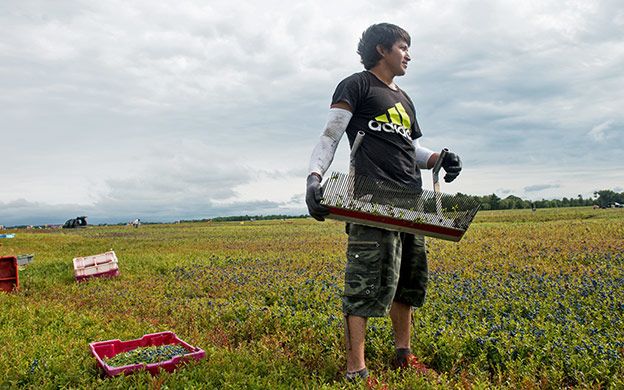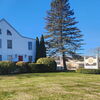
Processing Your Payment
Please do not leave this page until complete. This can take a few moments.
- News
-
Editions
View Digital Editions
Biweekly Issues
- December 1, 2025
- Nov. 17, 2025
- November 03, 2025
- October 20, 2025
- October 6, 2025
- September 22, 2025
- + More
Special Editions
- Lists
- Viewpoints
-
Our Events
Event Info
Award Honorees
- Calendar
- Biz Marketplace
Maine Food Insider: No wonder we feel so smart eating Maine wild blueberries
 Photo / Ted Axelrod, axelrodphotography.com
Maine's wild blueberry harvests of up to 100 million pounds a year represent a $250 million industry, according to the Wild Blueberry Commission of Maine. As researchers find increasing evidence that there are significant health benefits from eating wild blueberries, growers hope it will lead to expanded markets for Maine berries.
Photo / Ted Axelrod, axelrodphotography.com
Maine's wild blueberry harvests of up to 100 million pounds a year represent a $250 million industry, according to the Wild Blueberry Commission of Maine. As researchers find increasing evidence that there are significant health benefits from eating wild blueberries, growers hope it will lead to expanded markets for Maine berries.
When a group of 12 researchers met for the first Wild Blueberry Health Research Summit in 1998, the health benefits of blueberries were just being recognized — notably the potential of antioxidants to prevent or slow cancer.
At that time the wild blueberry — grown in Maine, and smaller, firmer and more tart than its plump cultivated cousin from away — was used mostly for baking.
Wild blueberry, you’ve come a long way in 20 years.
“We went from being a blueberry muffin berry, to being recognized as one of the healthiest superfoods you can eat,” said Nancy McBrady, executive director of the Wild Blueberry Commission of Maine, in a news release advancing this year’s summit, which was held last weekend in Bar Harbor.
The fact the berry had potential as a powerful antioxidant — a molecule that protects the body’s cells — was the primary focus at the first summit, which is hosted by the Wild Blueberry Association of North America.
But 20 years later, the antioxidant benefit “is only the tip of the iceberg,” said Mary Ann Lila, director of the Plants for Human Health Institute at North Carolina State University.
This year’s meeting drew 30 scientists, researchers and doctors who discussed the wild blueberry’s role in health areas from Alzheimer’s research to cancer prevention.
“At the onset of the [first] summit, we were just beginning to realize what’s inside the wild blueberry,” said Lila by email Monday from Quebec, where she and Kit Broihier, nutrition advisor for association, were attending a conference.
“The antioxidant health story was virtually unknown when we began,” Broihier said in the news release. “Yet is has become of the most powerful health narratives of our time.”
Wild blueberries' powerful health benefits

The discovery of how antioxidants benefit health was a breakthrough, leading to further research about how phytochemicals produced by plants to protect themselves from germs and other organisms play a role in human health.
Antioxidants are linked to improving chronic disease and the effects of aging, and that research now has led to wild blueberries’ powerful effects in half a dozen areas. Among the research discoveries about blueberries’ health benefits:
- Potential to improve brain health, particularly where memory and Alzheimer’s disease is concerned
- Potential to prevent and slow cancer
- Improves insulin sensitivity, which helps reduce the risk of diabetes and metabolic syndrome.
- Improves gastrointestinal health.
Some of this year’s focus was on plans to use human clinical trials to combat diabetes and cardiovascular disease, Lila said. The group also discussed how the berry affects gastrointestinal health in a way that strengthens the metabolism and protects against chronic illness.
Consumers love 'em
As important as wild blueberries are in the research lab, the importance in the grocery store isn’t lost on the association.
Lila said that all blueberries are good to eat and good for health, but the wild variety has much higher concentrations of phytoactives and other elements that make them so beneficial. “The general public is not as tuned in as they should be to the differences between the wild blueberry and their cultivated cousins,” she said.
Broihier said wild blueberries also have a more intense taste. “We tell people that if they like blueberries, then they’ll love wild blueberries,” she said in an email interview this week.
But before consumers can love them, they have to find them.
Maine is the world’s top producer of the wild blueberries, at up to 100 million pounds a year, which brings $250 million into the state, according to the Wild Blueberry Commission of Maine.
But most of the crop, which also is plentiful in the Canadian Maritimes, is flash-frozen and only available in grocery stores’ produce sections for a few weeks.
“There is some education we do as far as letting people know to look for wild blueberries in the freezer case,” she said. The frozen berries can be used in all the same ways fresh cultivated ones are, she added.
McBrady, of the state’s blueberry commission, said the scientific research and marketing efforts have complemented each other, something no one realized would happen at that first summit 20 years ago.
“The summit has provided top researchers with a platform to get their work in front of the general population through our marketing efforts,” McBrady said. “It has also been critical in helping us shape our understanding of the health benefits of wild blueberries, and how we should communicate those benefits to consumers.”
Broihier said that while she’s a nutritionist, not a marketer, she frequently is asked about the “wild nature” of the berries.
“More and more, consumers want to know details about their food: what’s in it, where it comes from and how their food can contribute to their overall health,” Broihier said. “These are all things that we focus on, and areas where wild blueberries have a great story to tell.
“Wild foods are a growing trend, and that bodes well for our little wild blueberries.”
Mainebiz web partners

The Giving Guide
The Giving Guide helps nonprofits have the opportunity to showcase and differentiate their organizations so that businesses better understand how they can contribute to a nonprofit’s mission and work.
Learn More
Work for ME
Work for ME is a workforce development tool to help Maine’s employers target Maine’s emerging workforce. Work for ME highlights each industry, its impact on Maine’s economy, the jobs available to entry-level workers, the training and education needed to get a career started.
Learn More
Groundbreaking Maine
Whether you’re a developer, financer, architect, or industry enthusiast, Groundbreaking Maine is crafted to be your go-to source for valuable insights in Maine’s real estate and construction community.
Learn more-
The Giving Guide
The Giving Guide helps nonprofits have the opportunity to showcase and differentiate their organizations so that businesses better understand how they can contribute to a nonprofit’s mission and work.
-
Work for ME
Work for ME is a workforce development tool to help Maine’s employers target Maine’s emerging workforce. Work for ME highlights each industry, its impact on Maine’s economy, the jobs available to entry-level workers, the training and education needed to get a career started.
-
Groundbreaking Maine
Whether you’re a developer, financer, architect, or industry enthusiast, Groundbreaking Maine is crafted to be your go-to source for valuable insights in Maine’s real estate and construction community.
ABOUT
NEW ENGLAND BUSINESS MEDIA SITES
No articles left
Get access now
In order to use this feature, we need some information from you. You can also login or register for a free account.
By clicking submit you are agreeing to our cookie usage and Privacy Policy
Already have an account? Login
Already have an account? Login
Want to create an account? Register
Get access now
In order to use this feature, we need some information from you. You can also login or register for a free account.
By clicking submit you are agreeing to our cookie usage and Privacy Policy
Already have an account? Login
Already have an account? Login
Want to create an account? Register






Comments